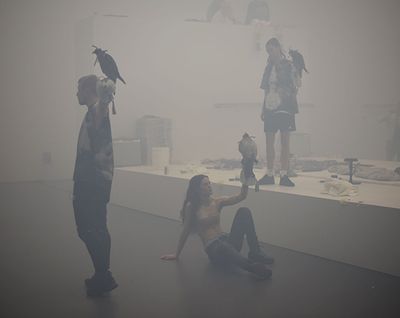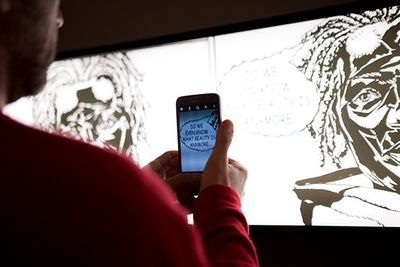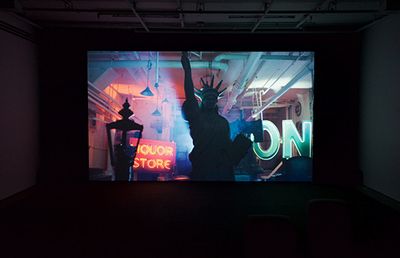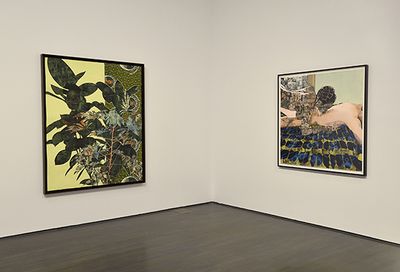Le Grand Balcon: Reflections on the 2016 La Biennale de Montréal

Anne Imhof, Angst III, 18 and 19 October 2016, 19h – 23h, Musée d’art contemporain Montreal. Photo: © Jonas Leihener. Courtesy of La Biennale de Montréal 2016.
The 2016 La Biennale de Montréal’s concept—which frames some 55 artists and collectives from 23 countries across eight venues (including The Montreal Museum of Fine Art, which hosts a new installment from Kerry James Marshall’s Rythm Mastr series)—feels fitting. Titled Le Grand Balcon, the exhibition draws ‘loosely’ on Jean Genet’s 1957 play Le Balcon, set in a brothel of ‘world-wide reputation’ that Genet refers to as ‘the most artful, yet the most decent house of illusions’. Here, punters play the roles of powerful state characters for their own gratification while a popular uprising unfolds outside.
In his curatorial statement, the Biennale's curator Philippe Pirotte (whose advisory team consisted of Corey McCorkle, Aseman Sabet and Kitty Scott) focuses on Le Balcon’s ‘fiercely ironical microcosm of the power elite besieged by revolutionary forces at the gates’. This focus is well-suited, given the rise of nationalist politics that stand counter to the neoliberal globalism that such events as biennials—often viewed as sites of political discourse on the one hand, and elitist echo chambers on the other—have come to represent. In the play, the brothel is where the perverse relationships between rebels and state actors are fostered and perpetuated through the shared pleasure either side takes in playing their respective roles. In the end, the revolution is essentially castrated by its own actions from within the brothel itself, where rebellions are doomed to form back into the state they seek to break.
A number of commissioned works invoke Genet’s incisive plot and relate it back to the art of image production beautifully. At the Musée d’art contemporain de Montréal, Luzie Meyer’s 2016 short film The Balcony recreates key scenes enacted by the three key roles in Genet’s story: the Judge, the Bishop, and the General, with Meyer positioned as both prostitute and director/filmmaker (mirroring the role of Madame Irma in the text, around whom the play’s action is centred). After introducing each character, Meyer takes the actors outside the studio and asks them to make statements they believe befit their costumes, to which ‘the Bishop’ responds: ‘If this film is about deconstructing itself, why don’t I just take the mic?’ The response illustrates the illusion as Genet saw it: in practice, the ‘image’, which Genet’s script ties to the role a person plays in both reality and fantasy, is but a vessel that awaits whomever is willing to take on the representation.
While Meyer’s version of Le Balcon focuses on the actors, _Fatal Act: Corpse Cleaner _(2016), at the gallery of The Université du Québec à Montréal (UQAM), offers an interpretation of Genet’s bordello in the Atomic Age. The short film by New York-based research and production collective Thirteen Black Cats is based on the correspondence between Claude Eatherly, the US air force pilot who gave the all clear for the Hiroshima bomb drop, and German philosopher, theorist and anti-nuclear activist Günther Anders, who referred to his time as a prop cleaner at the Hollywood Custom Palace as being ‘history’s corpse cleaner’. The film is a slow pan through a prop house, complete with Statue of Liberty, over which a single narrator speaks to these two men of history through imagined letters containing their own quotes.
At one point, the ‘bat bomb’ is discussed, which consisted of sleeping bats carrying time-bombs that would drop over a city at daybreak like ‘a scattering storm of forced suicides’. Developed by the US army during World War II, the weapon was never deployed but tested in New Mexico, and later in Utah, where a replica of a Japanese city was built—as the narrator notes, apparently with the help of Hollywood—for the purposes of incendiary trials. The creation of a stage for the purposes of war thus fuses with the legacy of Hollywood, which in turn recalls the thirty-eight studios Genet described as part of his shape-shifting brothel, ‘Every one of them gilded, and all of them rigged with machinery so as to be able to fit into and combine with each other.’
This description of interlocking studios forming a perverse house of political, historical, and fantastical mirrors and illusions is not lost on the interlocking spaces of this biennale, particularly at the Musée d’art contemporain de Montréal, where a bulk of the exhibition is staged. Here, a 1540 portrait of a lady by German Renaissance painter Lucas Cranach the Elder, described as a central work to the show, is installed. Believed either to be Judith or Salome, as modelled by Sidonia of Saxony, the painting is suspected to have once depicted a severed head of St John the Baptist or Holofernes. Yet, when looking at the descriptive text on the Montreal Biennale site and that of the Winnipeg Art Gallery, it is unclear as to whether this is confirmed knowledge or not. The slipperiness of fact hinged on the painting expands to frame this entire exhibition. On the loose reference to Genet’s Le Balcon, Pirotte proposes to enact Genet’s concern with ‘meta-theatricality and role-playing by unfolding incidents alongside “objects” that often refuse to reveal themselves as truths’.
In keeping, Cranach the Elder’s painting is surrounded by works that invoke a level of absence, from Hassan Khan’s 2015 film, The Slapper and the Cap of Invisibility, which features a grippingly urgent yet abstract performance improvised by Egyptian 1950s comedy star Ismail Yassin, and character actor Tewfiq El Deqn; Hüseyin Bahri Alptekin’s 2000 photographic series Arkadya’da Melankoli/Melancholia in Arcadia, which documents details in a sanatorium in Odessa, Ukraine; and Luc Tuymans series of paintings depicting the empty galleries of the Qatar Museums Gallery Al Riwaq, created especially for the show. Completing the grouping in a room Pirotte described as being ‘all about violence’, is Elaine Cameron-Weir’s impressive sculpture of three hanging ceramic snakeskins, SNAKE (2016), and Njideka Akunyili Crosby’s collage-paintings, Cassava Garden (2015) and Thread (2012), that explore the weight of inter-cultural relationships and identities using a tactile and personal formal language.
As part of the curatorial frame, another reference acts as the mirror to Genet’s spectre: that of the Marquis de Sade, whose ‘advocacy of pleasure uncovers the paradoxes of the bourgeois principle of formal equality by exposing the fact that fantasy categorically resists universalisation.’ (As Pirotte continues, ‘Fantasy is the absolutely individual way in which someone structures her/his “impossible” relation to things’—a point that seems to contradict Genet’s treatment of fantasy in Le Balcon as both an individual yet highly universal realm, given the generic state roles that visitors choose to embody in this particular house of illusions.) The reason, as Pirotte writes, is to seek out ‘a hedonistic politics far from the easy rewards of consumption, in an environment of potentially economic or political instrumentalization’—that is, an environment like the biennale exhibition, and its establishment format.
And yet, very little is done to subvert the staging of the biennale throughout, despite this self-aware curatorial position. Even if the intention was to create an ‘impolite’ exhibition that is sensual and material, the show comes across as highly well-mannered despite works that included the excellent early drawings and illustrations by Brian Jungen exploring globalised and colonised identities through such motifs as native-on-Mountie sodomy and circumcised dick inspection. This had much to do with the straightforward approach towards staging the show itself, which is—despite being very beautiful—ultimately conventional. This greatly hampers the stated aim to create ‘something quite radical’—that is, an ‘unruly and recalcitrant space that gives form to an aesthetics of resistance to the violence of quantification and categorization’.
In the end, the curatorial statement feels unfulfilled. This is particularly true when thinking about the issues it raises, including the globalized—yet specialized and often impenetrable—space of the biennale exhibition itself, which Pirotte seems to connect with the microcosm of Genet’s bordello. With little connection between the show’s loaded title and its staging, artists are left with the framework implied by the curatorial’s titular reference, as loose as it may be, in which image-makers are positioned as state-sanctioned, institutionalized and fetishized illusionists.
Exemplary is Germany’s 2017 Venice Biennale artist Anne Imhof’s Angst III (2016): a performance staged in the basement of the Musée d’art contemporain de Montréal that comes off like an abstraction of a night at a dive bar. The action is non-linear, improvisational and presented as solemn ritual; it consists of young performers lounging in a smoke and mist-filled room among packets of cigarettes and Vaseline. There is some silent dancing, a few bodies fall back in a performative trust exercise, and someone climbs a wall and pours cans of Diet Pepsi down the side of it—action that all gets seemingly elevated simply by the presence of live, masked falcons. To be fair, the work encapsulates the ‘playful’ and ‘fatalistic’ theme Pirotte was going for, but it also underscores a point Pirotte made during the opening tour about art that appears ‘on time’ being ‘boring’. With distinct Berlin circa-now aesthetics, you can’t get more ‘on time’ than Angst III.
And you can’t get more ‘on time’ than this Montreal Biennale, even if its curator abhors frameworks that either fetishise the present, as with the 9th Berlin Biennale, or look to the future, as in Okwui Enwezor’s 2015 Venice Biennale. But Le Grand Balcon does little to separate itself from the exhibitions it critiques, aside from asserting its difference. Concerns remain focused on ‘some of our pressing matters and their interconnectedness—our culture of waste and excess, the accelerating dematerialisation of the economy, and the global evolution towards a clash of prophesying communities.’ To respond, the exhibition covers all bases in a show that is at once global, of the present, and that seeks a politics of the future.
The result was actually a very good overview of contemporary practice, and an exploration of the concerns therein, with very few artists suffering from what is essentially a fantastic show. (Exemplary is the entire exhibition at UQAM, which offered Album XII, 2013–2014, Luis Jacob’s excellent composition of 148 found images lined up in a row along three gallery walls organised according to aesthetic trope—from the building, to the body—as its centrepiece.) Excellent works were chosen, and beautifully installed. These included two films presented in their own dedicated rooms: Eric Baudelaire’s new film Prelude to AKA Jihadi (2016), which maps the movements of a young French man who travelled to Syria and allegedly joined ISIS using Japanese avant-garde director and radical activist Masao Adachi’s 1969 film AKA Serial Killer as a template; and Luke Willis Thompson’s beautiful and important Cemetery of Uniforms and Liveries (2016), which restages Warhol’s 1964-66 Screen Tests with descendants of blue-on-black violence: the grandson of Dorothy ‘Cherry’ Groce, who was shot by police in Brixton in 1985, and the son of Joy Gardner, who was killed in London in 1993 during a police raid for her deportation.
But this does not detract from the disconnect between the exhibition’s conceptual platform and the show itself, as lovely as it was. Take, for example, Le Grand Balcon’s stated aim to deflect ‘every attempt to fit in or create an overarching narrative, to be introduced into a system of classification or to be pinned down’ in order to create ‘ a place of fallacy, where things can go astray.’ While admirable and timely as a position, this comes off as a self-conscious pre-emptive strike for such aneatly organised and cleverly framed show, particularly when putting the other curatorial statements surrounding the exhibition to task.
How would Genet have felt about a biennale such as this, named after and based on a play he wrote as an ornate yet raw and seductive yet unapologetic exposé, presumably not only of the establishment as he perceived it, but on his own complicity within it? (‘My books, like my plays, were written against myself’, he once wrote.) Le Balcon is a searing and stunning interrogation into the relation between reality and illusion, in which the author considered the brothel as the ideal metaphor for a site where politics becomes a practice of both powerful and pathetic make-believe, while reflecting on his own craft as an image-maker in the process. In turn, Le Grand Balcon doesn’t push its complicated and contradictory fiction far enough. —[O]
Le Grand Balcon [The Grand Balcony], the 2016 edition of La Biennale de Montréal, runs from 19 October 2016 to 15 January 201.














































































































































































